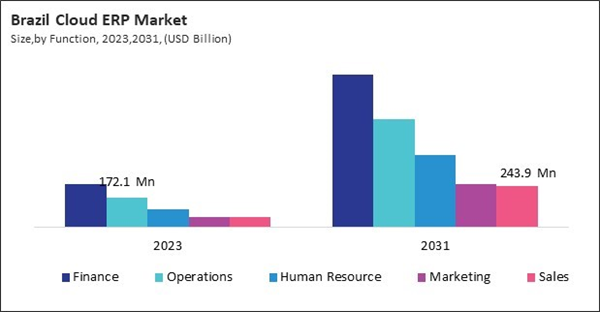The Latin America, Middle East and Africa Cloud ERP Market is expected to witness market growth of 19.9% CAGR during the forecast period (2024-2031).
The Brazil market dominated the LAMEA Cloud ERP Market by Country in 2023, and is expected to continue to be a dominant market till 2031; thereby, achieving a market value of $2.44 billion by 2031. The Argentina market is capturing a CAGR of 21.4% during 2024-2031. Additionally, the UAE market would register a CAGR of 18.7% during 2024-2031.
The market is witnessing several innovative developments reshaping the landscape. Cloud ERP systems increasingly incorporate AI and machine learning algorithms to provide predictive analytics, helping businesses forecast trends, optimize inventory, and improve decision-making processes. AI-driven automation features can streamline repetitive tasks, such as data entry and reporting, freeing employees to focus on higher-value activities.
Some Cloud ERP providers are exploring blockchain for enhanced data security and transparency, ensuring that transaction records are immutable and verifiable. Innovations in security protocols, such as machine learning-based anomaly detection, can help identify and mitigate threats in real-time. Cloud ERP systems integrate with IoT devices to capture real-time data from production lines, logistics, and supply chain operations, allowing for better visibility and responsiveness. IoT-enabled sensors can automate inventory tracking and replenishment, enhancing supply chain efficiency and reducing operational costs
The UAE government has been actively promoting digital transformation across various sectors as part of its vision to enhance the country’s competitiveness on the global stage. This initiative encourages businesses to adopt advanced technologies, including cloud ERP systems, to streamline operations, improve efficiency, and deliver better services.
With the UAE’s strategic focus on becoming a regional technology hub, companies increasingly recognize the importance of integrating cloud ERP solutions into their digital strategies. This shift is expected to contribute significantly to the growth of the region’s cloud ERP market. Therefore, the rising cloud sector and expansion of the healthcare industry are driving the market's growth.
The Brazil market dominated the LAMEA Cloud ERP Market by Country in 2023, and is expected to continue to be a dominant market till 2031; thereby, achieving a market value of $2.44 billion by 2031. The Argentina market is capturing a CAGR of 21.4% during 2024-2031. Additionally, the UAE market would register a CAGR of 18.7% during 2024-2031.
The market is witnessing several innovative developments reshaping the landscape. Cloud ERP systems increasingly incorporate AI and machine learning algorithms to provide predictive analytics, helping businesses forecast trends, optimize inventory, and improve decision-making processes. AI-driven automation features can streamline repetitive tasks, such as data entry and reporting, freeing employees to focus on higher-value activities.
Some Cloud ERP providers are exploring blockchain for enhanced data security and transparency, ensuring that transaction records are immutable and verifiable. Innovations in security protocols, such as machine learning-based anomaly detection, can help identify and mitigate threats in real-time. Cloud ERP systems integrate with IoT devices to capture real-time data from production lines, logistics, and supply chain operations, allowing for better visibility and responsiveness. IoT-enabled sensors can automate inventory tracking and replenishment, enhancing supply chain efficiency and reducing operational costs
The UAE government has been actively promoting digital transformation across various sectors as part of its vision to enhance the country’s competitiveness on the global stage. This initiative encourages businesses to adopt advanced technologies, including cloud ERP systems, to streamline operations, improve efficiency, and deliver better services.
With the UAE’s strategic focus on becoming a regional technology hub, companies increasingly recognize the importance of integrating cloud ERP solutions into their digital strategies. This shift is expected to contribute significantly to the growth of the region’s cloud ERP market. Therefore, the rising cloud sector and expansion of the healthcare industry are driving the market's growth.
List of Key Companies Profiled
- IBM Corporation
- Microsoft Corporation
- SAP SE
- Hewlett Packard Enterprise Company
- Oracle Corporation
- Epicor Software Corporation
- VMware, Inc. (Broadcom Inc.)
- Infor, Inc. (Koch Industries)
- Workday, Inc.
- SYSPRO (Advent International)
Market Report Segmentation
By Component
- Solution
- Services
- Managed
- Professional
By Organization Size
- Large Enterprises
- Small and Medium Enterprises
By Deployment Type
- Hybrid
- Public
- Private
By Function
- Finance
- Operations
- Human Resource
- Marketing
- Sales
By Vertical
- BFSI
- Manufacturing
- Telecom & IT
- Healthcare and Life Sciences
- Government
- Retail
- Aerospace & Defense
- Education
- Other Verticals
By Country
- Brazil
- Argentina
- UAE
- Saudi Arabia
- South Africa
- Nigeria
- Rest of LAMEA
Table of Contents
Chapter 1. Market Scope & Methodology
Chapter 2. Market at a Glance
Chapter 3. Market Overview
Chapter 4. Competition Analysis - Global
Chapter 5. LAMEA Cloud ERP Market by Component
Chapter 6. LAMEA Cloud ERP Market by Organization Size
Chapter 7. LAMEA Cloud ERP Market by Deployment Type
Chapter 8. LAMEA Cloud ERP Market by Function
Chapter 9. LAMEA Cloud ERP Market by Vertical
Chapter 10. LAMEA Cloud ERP Market by Country
Chapter 11. Company Profiles
Companies Mentioned
- IBM Corporation
- Microsoft Corporation
- SAP SE
- Hewlett Packard Enterprise Company
- Oracle Corporation
- Epicor Software Corporation
- VMware, Inc. (Broadcom Inc.)
- Infor, Inc. (Koch Industries)
- Workday, Inc.
- SYSPRO (Advent International)
Methodology

LOADING...









